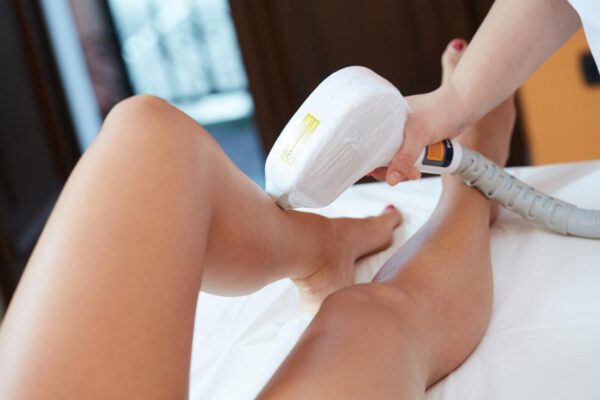
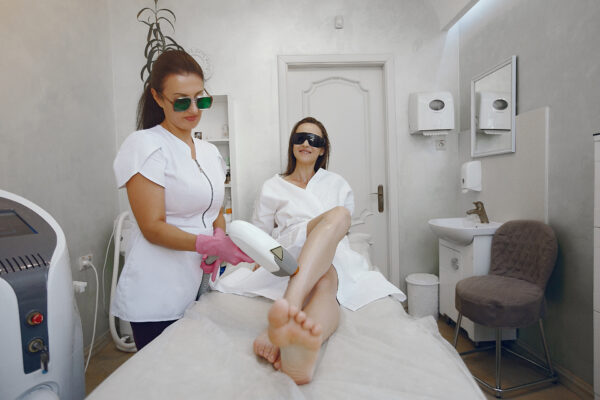
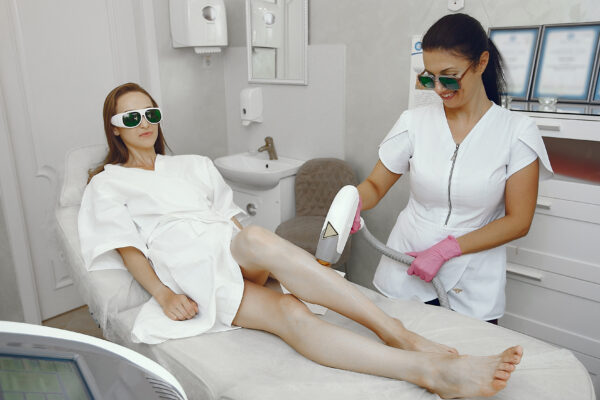
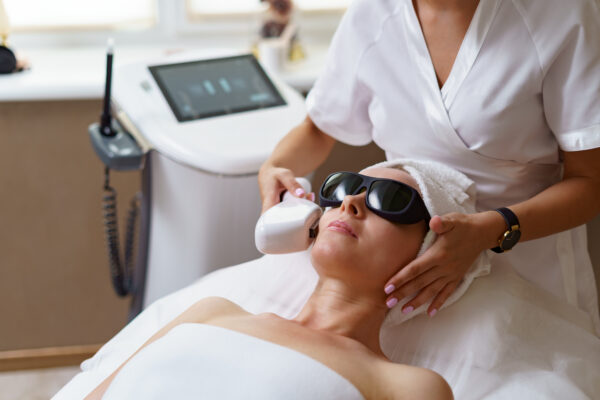
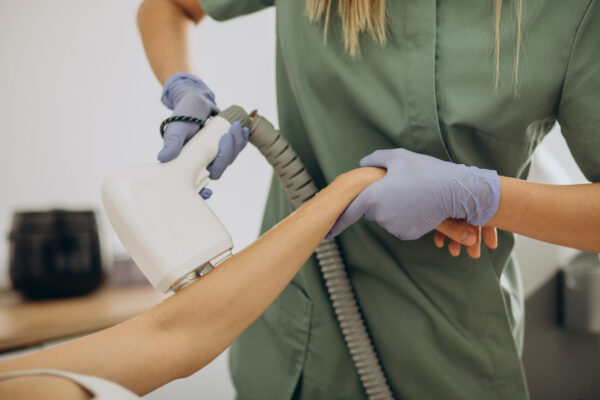
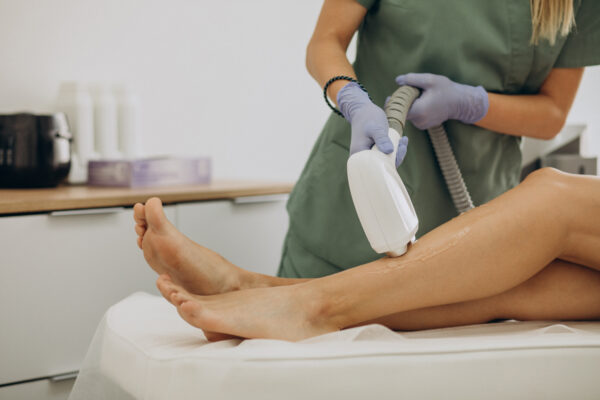
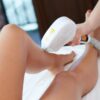

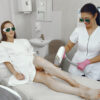
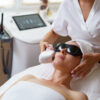

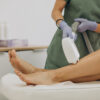

Free
Embark on a transformative journey with our exceptional range of medical treatments. As a leading medical tour operator, we offer a comprehensive selection of world-class treatments and procedures to address your unique healthcare needs. From advanced surgeries to cutting-edge therapies, our team of experienced professionals is dedicated to providing top-notch care and ensuring your comfort and satisfaction. Discover a new level of healthcare excellence with our tailored treatment options. Book now to start your journey towards a healthier and happier you.
The diode laser is a commonly used technology for laser hair removal. It emits a concentrated beam of light that targets the pigment (melanin) in the hair follicles. The principle behind diode laser hair removal is selective photothermolysis, which means that the laser energy is absorbed by the melanin in the hair shaft and follicle, damaging them while leaving the surrounding skin unharmed.
During the procedure, the diode laser is applied to the treatment area, and the laser energy is converted into heat. This heat damages the hair follicles, inhibiting or delaying future hair growth. It is important to note that diode laser hair removal provides long-term hair reduction rather than permanent removal. Multiple treatment sessions are usually required to achieve the desired results, as hair grows in different phases and not all follicles are active at the same time.
The effectiveness of diode laser hair removal can vary depending on factors such as skin type, hair color, and the skill and experience of the laser operator. It is generally more effective for individuals with lighter skin tones and darker hair. However, advancements in technology have made diode lasers suitable for a wider range of skin types.
After the procedure, it is common to experience temporary skin irritation, redness, and swelling in the treated area. These side effects usually subside within a few hours. It is important to follow postoperative care instructions provided by the dermatologist or clinic to ensure proper healing and minimize the risk of complications.
It is worth noting that diode laser hair removal is a medical procedure, and it is important to choose a qualified and experienced professional for the treatment. They will assess your skin and hair type, determine the appropriate settings for the laser, and provide personalized recommendations based on your individual needs.
The diode laser hair removal procedure is suitable for a wide range of individuals, but there are certain factors to consider. Here is a summary of the suitability of diode laser hair removal based on the search results:
Skin Tone Suitability: Diode laser hair removal is generally suitable for individuals with light to medium skin tones 1. However, advancements in technology have made diode lasers effective for a wider range of skin types.
Hair Tone Suitability: Diode lasers are most effective for individuals with light brown to black hair 1. The laser targets the pigment (melanin) in the hair follicles, so hair with more pigment tends to respond better to the treatment.
Body Area for Use: Diode laser hair removal can be used on various body areas, including the face, underarms, legs, bikini area, and back 2.
FDA Cleared: Diode lasers used for hair removal are typically FDA cleared, indicating that they have been deemed safe and effective for this purpose.
Based on the search results, diode laser hair removal may not be suitable for everyone. Here are some factors to consider:
Hair Color Suitability: Diode lasers are most effective for individuals with light brown to black hair. The laser targets the pigment (melanin) in the hair follicles, so hair with more pigment tends to respond better to the treatment. Individuals with lighter hair colors, such as blond or red hair, may not achieve optimal results with diode laser hair removal.
Skin Tone Suitability: Diode laser hair removal is generally suitable for individuals with light to medium skin tones. However, advancements in technology have made diode lasers effective for a wider range of skin types. Individuals with darker skin tones may require special considerations and adjustments in the laser settings to minimize the risk of complications.
Treatment Area: Diode laser hair removal can be used on various body areas, including the face, underarms, legs, bikini area, and back. However, it is important to consult with a qualified professional to determine the suitability of diode laser hair removal for specific treatment areas.
Expectations for Hair Reduction: It is important to understand that diode laser hair removal provides long-term hair reduction rather than permanent removal. While the treatment can significantly reduce hair growth, some hair may still regrow over time. The term “hair reduction” is often used instead of “hair removal” to reflect this aspect.
Individual Considerations: Each individual’s response to diode laser hair removal can vary based on factors such as hair density, skin sensitivity, and hormonal influences. Consulting with a qualified professional, such as a dermatologist or laser technician, is essential to determine if diode laser hair removal is the right choice based on individual characteristics and goals.
The diode laser hair removal procedure offers several advantages. Here are the benefits commonly associated with diode laser hair removal:
Effective for Various Skin Types: Diode lasers have been found to be effective for a wide range of skin types, including light to medium skin tones. Advancements in technology have made diode lasers suitable for a broader range of skin tones, including darker skin types.
Suitable for Different Hair Colors: While some laser hair removal methods are more effective for darker hair, diode lasers can target a variety of hair colors, including light brown to black hair. This makes diode laser hair removal a viable option for individuals with different hair colors.
Deep Penetration: Diode lasers have a longer wavelength, allowing them to penetrate deeper into the skin. This deeper penetration enables effective targeting of hair follicles, resulting in long-term hair reduction.
Large Treatment Areas: Diode lasers have fast repetition rates and can cover larger areas of the body quickly. This makes diode laser hair removal suitable for treating larger body areas, such as the legs, back, or chest.
Minimal Discomfort: Diode laser hair removal is generally well-tolerated, and many patients report minimal discomfort during the procedure. Some diode laser machines also incorporate cooling technology to further reduce any potential pain or discomfort.
Long-Term Hair Reduction: While diode laser hair removal does not guarantee permanent hair removal, it can provide long-term hair reduction. Multiple treatment sessions are typically required to achieve the desired results, and occasional maintenance sessions may be needed.
Versatility in Treatment Areas: Diode laser hair removal can be performed on various body areas, including the face, legs, underarms, bikini line, and more. This versatility allows individuals to target unwanted hair in multiple areas of the body.
While diode laser hair removal is generally considered safe and effective, there are potential complications and side effects to be aware of. Here are some of the complications associated with diode laser hair removal:
Skin Irritation and Redness: It is common to experience temporary skin irritation, redness, and swelling immediately after the procedure. These side effects usually subside within a few hours, but in some cases, they may persist for a few days.
Changes in Skin Pigmentation: Laser hair removal can sometimes cause temporary changes in skin pigmentation. This can manifest as darkening (hyperpigmentation) or lightening (hypopigmentation) of the treated area. These pigment changes are usually temporary but may persist for several months in rare cases.
Skin Sensitivity and Discomfort: Some individuals may experience increased skin sensitivity or discomfort during or after the procedure. This can range from mild discomfort to more significant pain, depending on individual pain tolerance and the treatment area.
Blisters and Burns: In rare cases, diode laser hair removal can cause blisters or burns on the skin. This is more likely to occur if the laser settings are not properly adjusted or if the treatment is performed by an inexperienced operator.
Scarring: While uncommon, laser hair removal can potentially lead to scarring. This is more likely to occur if the treated area is not properly cared for after the procedure or if there is an underlying skin condition that affects healing.
Eye Injury: It is essential to protect the eyes during laser hair removal to prevent potential eye injury. Both the patient and the operator should wear appropriate eye protection to shield against the laser light.
Preoperative care is an important aspect of preparing for diode laser hair removal. While the specific instructions may vary depending on the clinic and the individual’s needs, here are some general guidelines based on the search results:
Avoid Sun Exposure: It is recommended to avoid excessive sun exposure and tanning beds before laser hair removal. Sunburned or tanned skin can increase the risk of complications and may affect the effectiveness of the treatment. If sun exposure is unavoidable, it is crucial to use broad-spectrum sunscreen and protect the treated area.
Avoid Hair Removal Methods: In the weeks leading up to the procedure, it is generally advised to avoid plucking, waxing, electrolysis, or using depilatory creams. These methods remove the hair follicle, which is necessary for the laser to target during the treatment. Shaving is usually allowed and may be recommended before the procedure.
Inform the Provider: It is important to inform the laser technician or dermatologist about any medications, medical conditions, or skin sensitivities. Certain medications, such as isotretinoin (Accutane), may need to be discontinued before laser hair removal due to increased skin sensitivity.
Skin Preparation: Some clinics may recommend using a bleaching cream before the procedure, especially for individuals with darker skin types or recent suntans. This helps minimize the risk of adverse effects and optimize the effectiveness of the treatment.
Shave the Treatment Area: In most cases, the treatment area should be shaved prior to the procedure. This allows the laser to target the hair follicles beneath the skin without interference from the visible hair above the surface. However, it is important to follow the specific instructions provided by the clinic regarding shaving and the timing of the procedure.
Follow Clinic Guidelines: Each clinic may have its own specific preoperative care instructions. It is essential to carefully follow these guidelines to ensure the best possible outcome and minimize the risk of complications. This may include avoiding certain skincare products, exfoliation, or other activities that could irritate the skin before the procedure.
Proper postoperative care is essential to promote healing and minimize potential side effects after diode laser hair removal. While specific instructions may vary depending on the clinic and individual needs, here are some general guidelines based on the search results:
Apply Cool Compresses: Applying cool compresses to the treated area can help reduce discomfort, redness, and swelling. This can be done by placing a clean, cool cloth or ice pack on the skin for short periods of time.
Avoid Sun Exposure: It is crucial to protect the treated area from sun exposure. Direct sunlight can increase the risk of complications and may cause pigmentation changes. Use broad-spectrum sunscreen with a high SPF and cover the treated area with clothing or a hat when going outside.
Avoid Heat and Irritants: Avoid activities that may generate heat or irritate the treated area, such as hot showers, saunas, steam rooms, and excessive sweating. These can potentially worsen skin irritation and delay healing.
Avoid Hair Removal Methods: Refrain from plucking, waxing, or using depilatory creams on the treated area between sessions. These methods can disrupt the hair growth cycle and interfere with the effectiveness of the laser treatment.
Moisturize and Hydrate: Keep the treated area moisturized with a gentle, fragrance-free moisturizer recommended by your dermatologist or laser technician. Hydrating the skin can help soothe any dryness or irritation.
Avoid Scrubbing or Exfoliating: Avoid scrubbing or exfoliating the treated area for a few days after the procedure. This allows the skin to heal without unnecessary irritation.
Follow Clinic Guidelines: Each clinic may have its own specific postoperative care instructions. It is important to carefully follow these guidelines to ensure optimal healing and minimize the risk of complications. This may include avoiding certain skincare products, activities, or medications that could irritate the skin.
Contact Your Physician if Needed: If you experience severe pain, prolonged redness or swelling, blistering, or any other concerning symptoms, contact your physician or the clinic where the procedure was performed. They can provide guidance and address any potential issues.
Only logged in customers who have purchased this product may leave a review.
The Nd:YAG laser is commonly used for various dermatological procedures, including hair removal. However, it’s important to note that the effectiveness of Nd:YAG laser hair removal for permanent hair reduction is still a topic of debate. The laser emits a specific wavelength of light (1064 nm) that targets the pigment (melanin) in the hair follicles. The light energy is converted to heat, which damages the hair follicles and inhibits future hair growth.
Here is a general overview of the procedure for Nd:YAG laser hair removal:
Consultation: Before the procedure, you will typically have a consultation with a qualified professional, such as a dermatologist or laser technician. They will assess your eligibility for the treatment, discuss your goals, and explain the procedure in detail.
Preparation: Depending on the specific instructions provided by the practitioner, you may need to prepare the treatment area by shaving the hair a day or two before the procedure. This ensures that the laser targets the hair follicles beneath the skin surface.
Protection: Both you and the practitioner will wear protective eyewear to shield your eyes from the laser light during the procedure.
Application of the laser: The practitioner will use a handheld device that emits the Nd:YAG laser light. They will move the device over the treatment area, delivering short pulses of laser energy to the hair follicles.
Sensation: You may feel a mild sensation of heat or a snapping rubber band-like feeling during the procedure. The practitioner may use cooling techniques, such as a cooling gel or a chilled air device, to minimize discomfort.
Post-treatment care: After the procedure, you will receive specific post-treatment instructions from the practitioner. This may include avoiding sun exposure, applying soothing creams, and following any other recommendations to promote healing and minimize potential side effects.
Nd:YAG laser hair removal is suitable for various individuals, but there are some factors to consider. Here’s what the search results suggest:
All skin types: The Nd:YAG laser can be used safely on all skin types, including tanned skin 1. It is particularly recommended for individuals with darkly pigmented skin.
Dark hair: Nd:YAG laser hair removal is generally more effective for treating dark hair 1. It targets the pigment (melanin) in the hair follicles, making it less effective for light-colored or fine hair.
Fitzpatrick skin types I to III: The Nd:YAG laser is considered effective for treating dark (brown/black) hair in individuals with Fitzpatrick skin types I to III 2. It may also be effective for light-colored type IV skin 2.
Caution for light-colored hair: While the Nd:YAG laser can be effective for dark hair, it is generally less effective for light-colored (blonde/grey) hair 2.
Tanned or darker skin: The Nd:YAG laser is considered safe for use on tanned or darker skin tones However, caution is still recommended, and it’s important to consult with a qualified professional for personalized advice.
Based on the information from the search results, Nd:YAG laser hair removal may not be as suitable for the following individuals or conditions:
Light-colored or fine hair: Nd:YAG laser hair removal is generally less effective for light-colored (blonde/grey) hair compared to other lasers. The laser targets the pigment (melanin) in the hair follicles, and light-colored hair may have less melanin, making it less responsive to the treatment.
White or light hair: Nd:YAG laser hair removal is reported to be less effective on white or light hair compared to other lasers. The laser relies on the contrast between the hair color and the surrounding skin, and light-colored hair may not provide enough contrast for effective treatment.
The Nd:YAG laser hair removal system offers several advantages, as mentioned in the search results:
Suitable for all skin types: One of the significant advantages of Nd:YAG laser hair removal is its ability to safely and effectively treat all skin types, including darker and tanned skin. This is achieved due to the longer wavelength of the Nd:YAG laser, which reduces the risk of pigmentation changes and allows for deeper penetration into the skin 1.
Effective on larger treatment areas: The Nd:YAG laser has fast repetition rates and large coverage areas, allowing for the treatment of larger areas of the body in a shorter amount of time. This makes it a convenient option for individuals seeking hair removal on larger areas such as the back or legs 1.
Safe for darker skin tones: The Nd:YAG laser is considered ideal for treating patients with darker skin tones due to reduced scatter and deeper penetration of the laser light. It can be a safer option compared to other lasers for individuals with dark skin 2.
Reduced discomfort: The Nd:YAG laser system is reported to be more comfortable compared to other laser systems with faster repetitions. The longer wavelength of the Nd:YAG laser allows for fewer pulses of energy to be needed, resulting in shorter and more comfortable treatment sessions 3.
While Nd:YAG laser hair removal is generally considered safe and effective, there are some potential complications and side effects to be aware of. Here’s what the search results suggest:
Temporary side effects: After Nd:YAG laser hair removal, it is common to experience temporary side effects such as redness, irritation, and mild discomfort in the treated area. These side effects usually subside within a few hours to a few days.
Changes in skin color: In some cases, Nd:YAG laser hair removal may cause temporary changes in skin color, such as hyperpigmentation (darkening of the skin) or hypopigmentation (lightening of the skin). These changes are usually temporary but can persist for several weeks or months.
Crusting or blistering: In rare cases, Nd:YAG laser hair removal may cause crusting or blistering of the skin. This is more likely to occur if the laser settings are too aggressive or if the treated area is not properly cared for after the procedure.
Incomplete hair removal: While Nd:YAG laser hair removal can provide long-term hair reduction, it may not result in permanent hair removal. Multiple treatment sessions are usually required, and some hair regrowth may occur over time.
Discomfort during treatment: Some individuals may experience discomfort or a snapping rubber band-like sensation during the laser hair removal procedure. However, the discomfort is generally tolerable and can be minimized with cooling techniques or topical numbing creams.
Preoperative care for Nd:YAG laser hair removal typically involves a few important considerations. While the search results did not provide specific preoperative care instructions for Nd:YAG laser hair removal, here are some general guidelines that are commonly recommended for laser hair removal procedures:
Consultation: Before undergoing Nd:YAG laser hair removal, it is important to schedule a consultation with a qualified professional, such as a dermatologist or laser technician. During the consultation, they will assess your eligibility for the treatment, discuss your medical history, and provide personalized recommendations.
Avoid sun exposure: It is generally advised to avoid excessive sun exposure, tanning beds, and self-tanning products in the treatment area before the procedure. Sunburned or tanned skin can increase the risk of complications and may affect the effectiveness of the treatment.
Shave the treatment area: In most cases, the treatment area should be shaved a day or two before the procedure. This ensures that the laser targets the hair follicles beneath the skin surface, rather than the hair above the skin.
Avoid certain skincare products: It is advisable to avoid using skincare products that may irritate the skin or make it more sensitive before the procedure. This may include products containing retinoids, alpha-hydroxy acids (AHAs), or exfoliating agents. Your practitioner will provide specific instructions regarding skincare products to avoid.
Inform the practitioner: It is important to inform the practitioner about any medications, supplements, or medical conditions you have. Certain medications or medical conditions may affect the safety or effectiveness of the procedure.
Follow practitioner’s instructions: Your practitioner will provide you with specific preoperative instructions tailored to your individual needs. It is important to follow these instructions carefully to ensure the best possible outcome and minimize the risk of complications.
Postoperative care for Nd:YAG laser hair removal is important to ensure proper healing and minimize the risk of complications. While specific postoperative care instructions may vary depending on the practitioner and individual circumstances, here are some general guidelines:
Avoid sun exposure: After the procedure, it is advisable to avoid direct sun exposure and tanning beds in the treated area. Sunburned or tanned skin can increase the risk of complications and may interfere with the healing process.
Apply soothing creams or ointments: Your practitioner may recommend applying a soothing cream or ointment to the treated area to help alleviate any redness, irritation, or discomfort. Follow their instructions regarding the type and frequency of application.
Avoid hot baths and showers: It is generally recommended to avoid hot baths, showers, saunas, or activities that may cause excessive sweating for a few days after the procedure. This helps to prevent irritation and potential infection in the treated area.
Gentle cleansing: Cleanse the treated area gently with mild soap and water. Avoid scrubbing or using harsh exfoliants that may irritate the skin.
Avoid picking or scratching: It is important to resist the urge to pick or scratch the treated area, as this can increase the risk of infection and delay the healing process.
Avoid irritants: Avoid using skincare products or cosmetics that may contain harsh chemicals or irritants in the treated area until it has fully healed.
Follow-up appointments: Your practitioner may schedule follow-up appointments to monitor your progress and provide any necessary additional treatments or recommendations.
There are no reviews yet.
Only logged in customers who have purchased this product may leave a review.
Choosing the right hospital and physician are important factors to consider that significantly influence a patient’s treatment. The preferred choice for many patients is choosing private care.
Choosing the right hospital and physician are important factors to consider that significantly influence a patient’s treatment.
Reviews
There are no reviews yet.